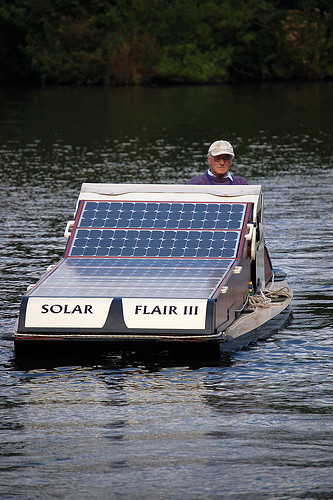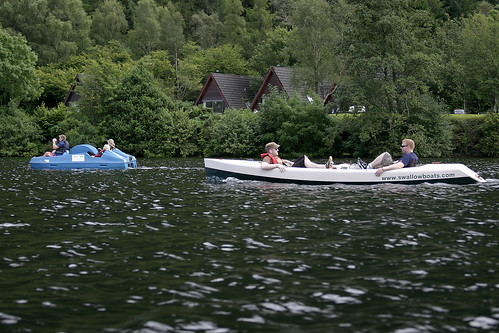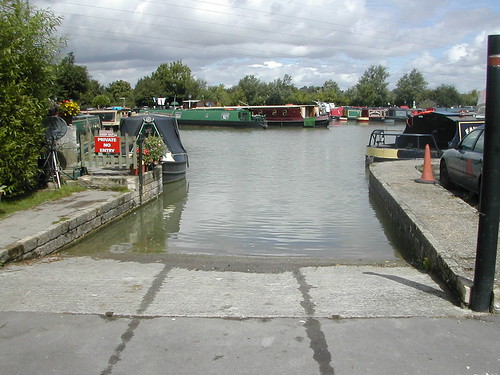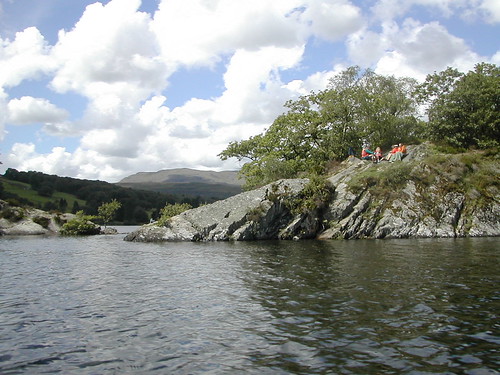We had hoped to explore the Thames more this summer, but the river has been too high a lot of the time. We purchased our Thames licences for 2007, but only ventured onto the river at the Beale Boat Show in June. We have since discovered that the licence gives us 30 days on the Environment Agency rivers in East Anglia as well, so it could still turn out to be a good investment!
We arrived about 11 and found Dave - who runs the most amazing chandlery as well as supervising the slipway at Lechlade Marina. It's a good slipway for Winsome, with ample space to offload and assemble the boat. Unfortunately, like most slipways, it caters best for boats you can board from the slipway itself or while they are on the launch trailer. We can't do that, and ideally we like there to be a jetty or quay nearby where we can haul Winsome alongside. So we were quite grateful for the apparently derelict motor boat dragged up on the slip.

Dave said Summer 2007 had been a complete write-off for many of the marine businesses on the Thames. The marina and his chandlery had been flooded, and he feared that some rental businesses would go out of business as a result, having lost all their income. It has evidently been some time since the Thames flooded this far up stream, and to do so at the height of the holiday season must have been a blow.
We managed to get aboard and underway by around 11:30 and set off downstream for Radcot - about 6 miles and a couple of locks away. We were planning on lunching there and returning.
The weather was sunny but not hot, and we quickly made it to St John's lock, which is the first on the Thames going downstream. You can go at least 10 miles upstream from Lechlade (if you can turn round) so these upper reaches of the river are pretty placid. The lock keeper at St Johns was intrigued by the boat, and while we waited for the lock to fill told us how he had avoided the worst of the floods with a timely holiday.

It turns out he is primarily responsible for managing the water level via the weirs on the Thames for his area. Perhaps this is why the Thames enjoys the luxury of manned locks - the REAL job of controlling the river levels requires a level of staffing that gives the agency the capacity to operate the locks as well. It is certainly much more efficient and safer going through a manned lock.
St Johns lock is not particularly deep in canal terms, and has landing points above and below. We would not be able to port Winsome round the lock, though, because there is no clear towpath or the kind of quayside you could launch Winsome from. Indian canoes and kayaks could be hauled out, but the locks are generally so quick and efficient that it might not be worth the hassle unless the river is very busy. St Johns is the only lock on this stretch with a loo!

The lock-keeper told us that the next two lock we were to go through would not be manned that day, so I paid particular attention to the paddle mechanisms. When going into a lock witb Winsome, it's generally best for the bigger boats to go first because you don't want to be crushed from behind by a large boat being unable to stop. The water entering the lock does, however, create some turbulence, so sympathetic operation of the paddles can make for a smoother passage for smaller boats.
The bad news is that generally, boats emerge from a lock in the same order they went in, so it looked like we were going to be behind the motor boat that arrived just after us at the lock. But they generously waved us through, so that we had a free run down to the next lock at Buscot which was fortunately filling up with some boats coming up stream. I say "fortunately", because the general rule is that the Thames locks are left empty, which delays downstream traffic on an empty river.

Now we were operating an unmanned lock, but passers-by are always willing to help, and some of them seem to know what they are doing. When entering a full lock going down, you must shut the upstream gates and close their paddles before opening the paddles in the down stream gates to let the water out of the lock. You do this in two stages to limit the flow of water within the lock, but when the lock is empty you can open the lower gates and head off. It's polite to close the paddles before you set off, because they will need to be closed to fill the lock again. On this stretch of the Thames, you cross the lock by gangways on the gates themselves, so when you open a gate don't want to have to cross the lock again. In particular, you can often get away with opening only one of the gates until the boats have exited the lock, before closing it again and rejoining the boat at the mooring below or above the lock.
Locks work a bit like traffic lights, bunchng the traffic and normalising average speed on the river. On the Thames, Winsome isn't the fastest boat, but going downstream on this stretch she is quicker than the average cruiser or narrow boat. But not so much faster that she can get through the next lock before the arrival of the boats with which she shared the last one. The GPS said we were averaging about 4.5 mph down stream, and I was concerned that there was quite a bit more stream than we had noticed on our last visit.

At the next lock, we caught up with a narrow boat who generously delayed his departure for us, and even waved us ahead. We felt obliged to put on a bit of a spurt so as not to hold him up, and so arrived at Radcot fully 10 minutes ahead of him.


Just in time for a leisurely lunch, but alas the Swan Hotel was badly overstretched and lunch turned out to be rather too leisurely for our schedule. Rested and fuelled on cider and crisps, we set off back upstream, but decided to use the slower running channel under the old bridge at Radcot.


This turned out to be a mistake. A slow running backwater accumulates vegetation and the prop quickly picked up a clump from hell. This is a good time to be occupying the bow seat, from which you can sit back and take embarrassing photographs of the helmswomen clearing the prop and rudder from within the boat, just as the manual prescribes. Still, it could have been raining!
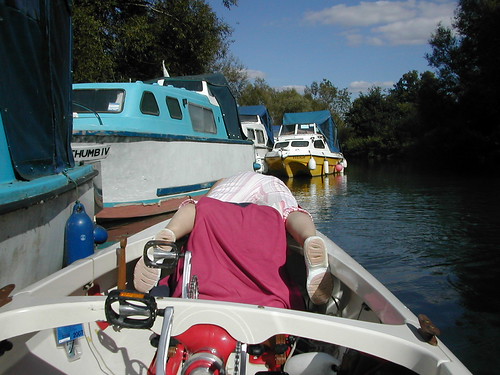
As we cruised back up stream, it didn't feel like harder work, but the GPS showed that we were now managing only about 3.9mph. I make that a river flow of (4.5 - 3.9 / 2) or less than a third of a mile per hour. Hardly a spate, though noticeably faster than we'd experienced here the last time we came. The floods had dumped quite a bit more vegetation in the river, and we picked up some more as we worked our way back up stream. You can often lose vegetation by back-pedalling for a spell, but we did have to stop and pull another piece off the rudder. Still, compared with our canal in the autumn, the Thames was remarkably free of crud. It is also spectacularly clear in this stretch, presumably as it starts to enter the chalk belt.
Our return trip was uneventful except for a poor execution of lock filling at Buscot. On our own except for the inevitable large crowd of admirers, I attempted to open the upstream gate before the lock had completely filled. This feels remarkably like the dreaded "lockgate jam" situation, which can happen but is thankfully rare. I was gently returned tothe paths of righteousness by a friendly and knowledgeable passer-by, so I won't make that mistake again.

And so we arrived back at Lechlade and enetered the marina at about 4pm, having cruised 12.3 miles on the GPS with an hour's stop for lunch. It wasn't quite as much exercise as walking the same distance, but it was certainly more interesting (for us). And it confirmed that Winsome really feels at home on the Thames. We wondered if the Cotswold Canal will be restored from Lechlade to Saul Junction on the Gloucester and Sharpness Canal in our lifetime. But even if it is, alas, the number of locks may make the trip infeasible with our remaining lifespan.



















